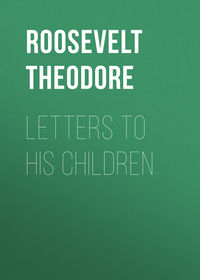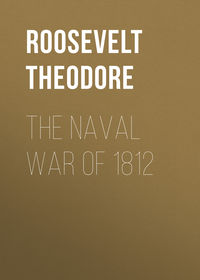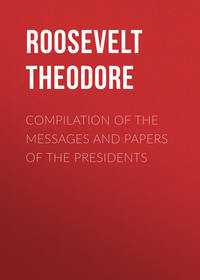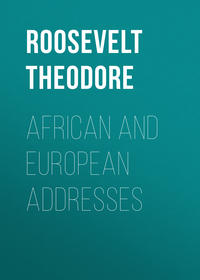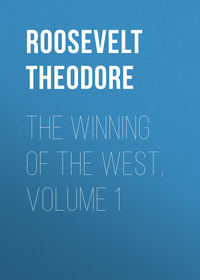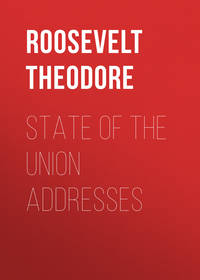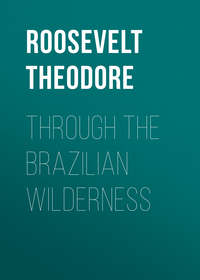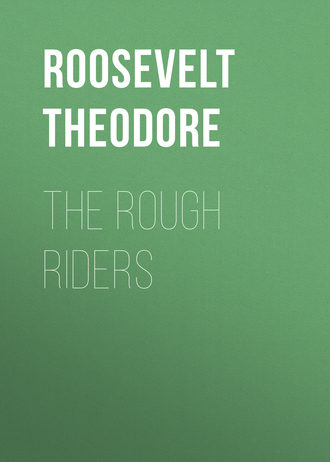 полная версия
полная версияThe Rough Riders
Mr. Bonsal out-Spaniards the Spaniards themselves as regards both their numbers and their loss. These points are discussed elsewhere. He develops for the Spanish side, to account for their retreat, a wholly new explanation—viz., that they retreated because they saw reinforcements arriving for the Americans. The Spaniards themselves make no such claim. Lieutenant Tejeiro asserts that they retreated because news had come of a (wholly mythical) American advance on Morro Castle. The Spanish official report simply says that the Americans were repulsed; which is about as accurate a statement as the other two. All three explanations, those by General Rubin, by Lieutenant Tejeiro, and by Mr. Bonsal alike, are precisely on a par with the first Spanish official report of the battle of Manila Bay, in which Admiral Dewey was described as having been repulsed and forced to retire.
There are one or two minor mistakes made by Mr. Bonsal. He states that on the roster of the officers of the Rough Riders there were ten West Pointers. There were three, one of whom resigned. Only two were in the fighting. He also states that after Las Guasimas Brigadier-General Young was made a Major-General and Colonel Wood a Brigadier-General, while the commanding officers of the First and Tenth Cavalry were ignored in this "shower of promotions." In the first place, the commanding officers of the First and Tenth Cavalry were not in the fight—only one squadron of each having been present. In the next place, there was no "shower of promotions" at all. Nobody was promoted except General Young, save to fill the vacancies caused by death or by the promotion of General Young. Wood was not promoted because of this fight. General Young most deservedly was promoted. Soon after the fight he fell sick. The command of the brigade then fell upon Wood, simply because he had higher rank than the other two regimental commanders of the brigade; and I then took command of the regiment exactly as Lieutenant-Colonels Veile and Baldwin had already taken command of the First and Tenth Cavalry when their superior officers were put in charge of brigades. After the San Juan fighting, in which Wood commanded a brigade, he was made a Brigadier-General and I was then promoted to the nominal command of the regiment, which I was already commanding in reality.
Mr. Bonsal's claim of superior efficiency for the colored regular regiments as compared with the white regular regiments does not merit discussion. He asserts that General Wheeler brought on the Guasimas fight in defiance of orders. Lieutenant Miley, in his book, "In Cuba with Shafter," on page 83, shows that General Wheeler made his fight before receiving the order which it is claimed he disobeyed. General Wheeler was in command ashore; he was told to get in touch with the enemy, and, being a man with the "fighting edge," this meant that he was certain to fight. No general who was worth his salt would have failed to fight under such conditions; the only question would be as to how the fight was to be made. War means fighting; and the soldier's cardinal sin is timidity.
General Wheeler remained throughout steadfast against any retreat from before Santiago. But the merit of keeping the army before Santiago, without withdrawal, until the city fell, belongs to the authorities at Washington, who at this all-important stage of the operations showed to marked advantage in overruling the proposals made by the highest generals in the field looking toward partial retreat or toward the abandonment of the effort to take the city.
The following note, written by Sergeant E. G. Norton, of B Troop, refers to the death of his brother, Oliver B. Norton, one of the most gallant and soldierly men in the regiment:
On July 1st I, together with Sergeant Campbell and Troopers Bardshar and Dudley Dean and my brother who was killed and some others, was at the front of the column right behind you. We moved forward, following you as you rode, to where we came upon the troopers of the Ninth Cavalry and a part of the First lying down. I heard the conversation between you and one or two of the officers of the Ninth Cavalry. You ordered a charge, and the regular officers answered that they had no orders to move ahead; whereupon you said: "Then let us through," and marched forward through the lines, our regiment following. The men of the Ninth and First Cavalry then jumped up and came forward with us. Then you waved your hat and gave the command to charge and we went up the hill. On the top of Kettle Hill my brother, Oliver B. Norton, was shot through the head and in the right wrist. It was just as you started to lead the charge on the San Juan hills ahead of us; we saw that the regiment did not know you had gone and were not following, and my brother said, "For God's sake follow the Colonel," and as he rose the bullet went through his head.
In reference to Mr. Bonsal's account of the Guasimas fight, Mr.
Richard Harding Davis writes me as follows:
We had already halted several times to give the men a chance to rest, and when we halted for the last time I thought it was for this same purpose, and began taking photographs of the men of L Troop, who were so near that they asked me to be sure and save them a photograph. Wood had twice disappeared down the trail beyond them and returned. As he came back for the second time I remember that you walked up to him (we were all dismounted then), and saluted and said: "Colonel, Doctor La Motte reports that the pace is too fast for the men, and that over fifty have fallen out from exhaustion." Wood replied sharply: "I have no time to bother with sick men now." You replied, more in answer, I suppose, to his tone than to his words: "I merely repeated what the Surgeon reported to me." Wood then turned and said in explanation: "I have no time for them now; I mean that we are in sight of the enemy."
This was the only information we received that the men of L Troop had been ambushed by the Spaniards, and, if they were, they were very calm about it, and I certainly was taking photographs of them at the time, and the rest of the regiment, instead of being half an hour's march away, was seated comfortably along the trail not twenty feet distant from the men of L Troop. You deployed G Troop under Captain Llewellen into the jungle at the right and sent K Troop after it, and Wood ordered Troops E and F into the field on our left. It must have been from ten to fifteen minutes after Capron and Wood had located the Spaniards before either side fired a shot. When the firing did come I went over to you and joined G Troop and a detachment of K Troop under Woodbury Kane, and we located more of the enemy on a ridge.
If it is to be ambushed when you find the enemy exactly where you went to find him, and your scouts see him soon enough to give you sufficient time to spread five troops in skirmish order to attack him, and you then drive him back out of three positions for a mile and a half, then most certainly, as Bonsal says, "L Troop of the Rough Riders was ambushed by the Spaniards on the morning of June 24th."
General Wood also writes me at length about Mr. Bonsal's book, stating that his account of the Guasimas fight is without foundation in fact. He says: "We had five troops completely deployed before the first shot was fired. Captain Capron was not wounded until the fight had been going on fully thirty-five minutes. The statement that Captain Capron's troop was ambushed is absolutely untrue. We had been informed, as you know, by Castillo's people that we should find the dead guerilla a few hundred yards on the Siboney side of the Spanish lines."
He then alludes to the waving of the guidon by K Troop as "the only means of communication with the regulars." He mentions that his orders did not come from General Wheeler, and that he had no instructions from General Wheeler directly or indirectly at any time previous to the fight.
General Wood does not think that I give quite enough credit to the Rough Riders as compared to the regulars in this Guasimas fight, and believes that I greatly underestimate the Spanish force and loss, and that Lieutenant Tejeiro is not to be trusted at all on these points. He states that we began the fight ten minutes before the regulars, and that the main attack was made and decided by us. This was the view that I and all the rest of us in the regiment took at the time; but as I had found since that the members of the First and Tenth Regular Regiments held with equal sincerity the view that the main part was taken by their own commands, I have come to the conclusion that the way I have described the action is substantially correct. Owing to the fact that the Tenth Cavalry, which was originally in support, moved forward until it got mixed with the First, it is very difficult to get the exact relative position of the different troops of the First and Tenth in making the advance. Beck and Galbraith were on the left; apparently Wainwright was farthest over on the right. General Wood states that Leonardo Ros, the Civil Governor of Santiago at the time of the surrender, told him that the Spanish force at Guasimas consisted of not less than 2,600 men, and that there were nearly 300 of them killed and wounded. I do not myself see how it was possible for us, as we were the attacking party and were advancing against superior numbers well sheltered, to inflict five times as much damage as we received; but as we buried eleven dead Spaniards, and as they carried off some of their dead, I believe the loss to have been very much heavier than Lieutenant Tejeiro reports.
General Wood believes that in following Lieutenant Tejeiro I have greatly underestimated the number of Spanish troops who were defending Santiago on July 1st, and here I think he completely makes out his case, he taking the view that Lieutenant Tejeiro's statements were made for the purpose of saving Spanish honor. On this point his letter runs as follows:
A word in regard to the number of troops in Santiago. I have had, during my long association here, a good many opportunities to get information which you have not got and probably never will get; that is, information from parties who were actually in the fight, who are now residents of the city; also information which came to me as commanding officer of the city directly after the surrender.
To sum up briefly as follows: The Spanish surrendered in Santiago 12,000 men. We shipped from Santiago something over 14,000 men. The 2,000 additional were troops that came in from San Luis, Songo, and small up-country posts. The 12,000 in the city, minus the force of General Iscario, 3,300 infantry and 680 cavalry, or in round numbers 4,000 men (who entered the city just after the battles of San Juan and El Caney), leaves 8,000 regulars, plus the dead, plus Cervera's marines and blue-jackets, which he himself admits landing in the neighborhood of 1,200 (and reports here are that he landed 1,380), and plus the Spanish Volunteer Battalion, which was between 800 and 900 men (this statement I have from the lieutenant-colonel of this very battalion), gives us in round numbers, present for duty on the morning of July 1st, not less than 10,500 men. These men were distributed 890 at Caney, two companies of artillery at Morro, one at Socapa, and half a company at Puenta Gorda; in all, not over 500 or 600 men, but for the sake of argument we can say a thousand. In round numbers, then, we had immediately about the city 8,500 troops. These were scattered from the cemetery around to Aguadores. In front of us, actually in the trenches, there could not by any possible method of figuring have been less than 6,000 men. You can twist it any way you want to;
the figures I have given you are absolutely correct, at least they are absolutely on the side of safety.
It is difficult for me to withstand the temptation to tell what has befallen some of my men since the regiment disbanded; how McGinty, after spending some weeks in Roosevelt Hospital in New York with an attack of fever, determined to call upon his captain, Woodbury Kane, when he got out, and procuring a horse rode until he found Kane's house, when he hitched the horse to a lamp-post and strolled in; how Cherokee Bill married a wife in Hoboken, and as that pleasant city ultimately proved an uncongenial field for his activities, how I had to send both himself and his wife out to the Territory; how Happy Jack, haunted by visions of the social methods obtaining in the best saloons of Arizona, applied for the position of "bouncer out" at the Executive Chamber when I was elected Governor, and how I got him a job at railroading instead, and finally had to ship him back to his own Territory also; how a valued friend from a cow ranch in the remote West accepted a pressing invitation to spend a few days at the home of another ex-trooper, a New Yorker of fastidious instincts, and arrived with an umbrella as his only baggage; how poor Holderman and Pollock both died and were buried with military honors, all of Pollock's tribesmen coming to the burial; how Tom Isbell joined Buffalo Bill's Wild West Show, and how, on the other hand, George Rowland scornfully refused to remain in the East at all, writing to a gallant young New Yorker who had been his bunkie: "Well, old boy, I am glad I didn't go home with you for them people to look at, because I ain't a Buffalo or a rhinoceros or a giraffe, and I don't like to be stared at, and you know we didn't do no hard fighting down there. I have been in closer places than that right here in United States, that is better men to fight than them dam Spaniards." In another letter Rowland tells of the fate of Tom Darnell, the rider, he who rode the sorrel horse of the Third Cavalry: "There ain't much news to write of except poor old Tom Darnell got killed about a month ago. Tom and another fellow had a fight and he shot Tom through the heart and Tom was dead when he hit the floor. Tom was sure a good old boy, and I sure hated to hear of him going, and he had plenty of grit too. No man ever called on him for a fight that he didn't get it."
My men were children of the dragon's blood, and if they had no outland foe to fight and no outlet for their vigorous and daring energy, there was always the chance of their fighting one another: but the great majority, if given the chance to do hard or dangerous work, availed themselves of it with the utmost eagerness, and though fever sickened and weakened them so that many died from it during the few months following their return, yet, as a whole, they are now doing fairly well. A few have shot other men or been shot themselves; a few ran for office and got elected, like Llewellen and Luna in New Mexico, or defeated, like Brodie and Wilcox in Arizona; some have been trying hard to get to the Philippines; some have returned to college, or to the law, or the factory, or the counting-room; most of them have gone back to the mine, the ranch, and the hunting camp; and the great majority have taken up the threads of their lives where they dropped them when the Maine was blown up and the country called to arms.
1
See Lieutenant Muller y Tejeiro, "Combates y Capitulacion de Santiago de Cuba," page 136. The Lieutenant speaks as if only one echelon, of seven companies and two guns, was engaged on the 24th. The official report says distinctly, "General Rubin's column," which consisted of the companies detailed. By turning to page 146, where Lieutenant Tejeiro enumerates the strength of the various companies, it will be seen that they averaged over 110 men apiece; this probably does not include officers, and is probably an under-statement anyhow. On page 261 he makes the Spanish loss at Las Guasimas, which he calls Sevilla, 9 killed and 27 wounded. Very possibly he includes only the Spanish regulars; two of the Spaniards we slew, over on the left, were in brown, instead of the light blue of the regulars, and were doubtless guerillas.
2
Lieutenant Tejeiro, p. 154, speaks of this attempt to retake San Juan and its failure.
3
According to the official reports, 5,104 officers and men of Kent's infantry, and 2,649 of the cavalry had been landed. My regiment is put down as 542 strong, instead of the real figure, 490, the difference being due to men who were in hospital and on guard at the seashore, etc. In other words, the total represents the total landed; the details, etc., are included. General Wheeler, in his report of July 7th, puts these details as about fifteen per cent of the whole of the force which was on the transports; about eighty-five per cent got forward and was in the fight.
4
The total Spanish force in Santiago under General Linares was 6,000: 4,000 regulars, 1,000 volunteers, and 1,000 marines and sailors from the ships. (Diary of the British Consul, Frederick W. Ramsden, entry of July 1st.) Four thousand more troops entered next day. Of the 6,000 troops, 600 or thereabouts were at El Caney, and 900 in the forts at the mouth of the harbor. Lieutenant Tejeiro states that there were 520 men at El Caney, 970 in the forts at the mouth of the harbor, and 3,000 in the lines, not counting the cavalry and civil guard which were in reserve. He certainly very much understates the Spanish force; thus he nowhere accounts for the engineers mentioned on p. 135; and his figures would make the total number of Spanish artillerymen but 32. He excludes the cavalry, the civil guard, and the marines which had been stationed at the Plaza del Toros; yet he later mentions that these marines were brought up, and their commander, Bustamente, severely wounded; he states that the cavalry advanced to cover the retreat of the infantry, and I myself saw the cavalry come forward, for the most part dismounted, when the Spaniards attempted a forward movement late in the afternoon, and we shot many of their horses; while later I saw and conversed with officers and men of the civil guard who had been wounded at the same time—this in connection with returning them their wives and children, after the latter had fled from the city. Although the engineers are excluded, Lieutenant Tejeiro mentions that their colonel, as well as the colonel of the artillery, was wounded. Four thousand five hundred is surely an understatement of the forces which resisted the attack of the forces under Wheeler. Lieutenant Tejeiro is very careless in his figures. Thus in one place he states that the position of San Juan was held by two companies comprising 250 soldiers. Later he says it was held by three companies, whose strength he puts at 300—thus making them average 100 instead of 125 men apiece. He then mentions another echelon of two companies, so situated as to cross their fire with the others. Doubtless the block-house and trenches at Fort San Juan proper were only held by three or four hundred men; they were taken by the Sixth and Sixteenth Infantry under Hawkins's immediate command; and they formed but one point in the line of hills, trenches, ranch-houses, and block-houses which the Spaniards held, and from which we drove them. When the city capitulated later, over 8,000 unwounded troops and over 16,000 rifles and carbines were surrendered; by that time the marines and sailors had of course gone, and the volunteers had disbanded.
In all these figures I have taken merely the statements from the Spanish side. I am inclined to think the actual numbers were much greater than those here given. Lieutenant Wiley, in his book In Cuba with Shafter, which is practically an official statement, states that nearly 11,000 Spanish troops were surrendered; and this is the number given by the Spaniards themselves in the remarkable letter the captured soldiers addressed to General Shafter, which Wiley quotes in full. Lieutenant Tejeiro, in his chap. xiv., explains that the volunteers had disbanded before the end came, and the marines and sailors had of course gone, while nearly a thousand men had been killed or captured or had died of wounds and disease, so that there must have been at least 14,000 all told. Subtracting the reinforcements who arrived on the 2nd, this would mean about 10,000 Spaniards present on the 1st; in which case Kent and Wheeler were opposed by at least equal numbers.
In dealing with the Spanish losses, Lieutenant Tejeiro contradicts himself. He puts their total loss on this day at 593, including 94 killed, 121 missing, and 2 prisoners—217 in all. Yet he states that of the 520 men at Caney but 80 got back, the remaining 440 being killed, captured, or missing. When we captured the city we found in the hospitals over 2,000 seriously wounded and sick Spaniards; on making inquiries, I found that over a third were wounded. From these facts I feel that it is safe to put down the total Spanish loss in battle as at least 1,200, of whom over a thousand were killed and wounded.
Lieutenant Tejeiro, while rightly claiming credit for the courage shown by the Spaniards, also praises the courage and resolution of the Americans, saying that they fought, "con un arrojo y una decision verdaderamente admirables." He dwells repeatedly upon the determination with which our troops kept charging though themselves unprotected by cover. As for the Spanish troops, all who fought them that day will most freely admit the courage they showed. At El Caney, where they were nearly hemmed in, they made a most desperate defence; at San Juan the way to retreat was open, and so, though they were seven times as numerous, they fought with less desperation, but still very gallantly.
5
This is probably an understatement. Lieutenant Muller, in chap. xxxviii. of his book, says that there were "eight or nine thousand;" this is exclusive of the men from the fleet, and apparently also of many of the volunteers (see chap. xiv.), all of whom were present on July 2nd. I am inclined to think that on the evening of that day there were more Spanish troops inside Santiago than there were American troops outside.
6
See Parker's "With the Gatlings at Santiago."
7
The other two must have followed on their own initiative.
8
These were the Spaniards in the trenches we carried when we charged from Kettle Hill, after the infantry had taken the San Juan block-house.




